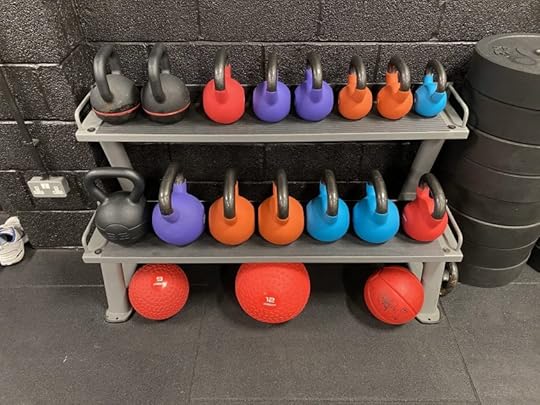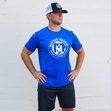Russian vs American Kettlebell Swings: Differences & Why You Need Both
One of the biggest arguments that has raged in the fitness community over the last 20 years is the difference between ‘Russian vs American kettlebell swings.’ It shows no signs of stopping any time soon!
On one hand, the purists favor the Russian swing. The CrossFit community invented and coaches the ‘American’ kettlebell swing. The rest of the fitness & coaching community exists on a continuum between the two.
To lay my thoughts out to begin with, I’m not married to either. I like and use both exercises.
I believe all exercises are tools and there’s an appropriate role for them all. My job is to help my clients, and I use whatever methods I believe will help them the most. Along with dumbbells, kettlebells are one of the most versatile and compact pieces of gym equipment that can be used for dozens (if not hundreds) of exercises and variations.

So in this article I’m going to explain the differences between the Russian and American kettlebell swing, and why you might need both in your training.
I’ll draw on the evidence from both sides, and throw in a sprinkling of my own anecdotal observations from 20+ years working as a personal trainer and gym owner. When you’ve used kettlebells for as long as I have, you notice a thing or two.
I’ll start by outlining both of the movements, so you know exactly what I’m referring to with each…
The Russian Kettlebell SwingWhen you picture a kettlebell swing, the chances are you’re thinking of a Russian swing. Straight back, hip flexion and powerful extension, with deliberate quad and glute engagement. The kettlebell reaches chest height.
It looks like this.
[image error]This is the movement brought to the US by Pavel Tsatsouline. Amongst purists, it’s the only kettlebell swing worth performing. It’s the heaviest swing, and proponents of it say it’s the safest and most appropriate version of the exercise.
The American Kettlebell SwingCrossFit introduced the ‘American’ kettlebell swing to the fitness community in the late 90s-early 2000s. It’s fundamentally the same move as the Russian swing to the chest, but with the American swing you continue to take the kettlebell overhead.
It looks like this.

The CrossFit movement (possibly to be purposely controversial) calls this a kettlebell swing, rather than an American kettlebell swing. They say they prefer it because it allows a lifter to work harder and increase the intensity of the movement. We’ll come to this later.
What are the similarities between the movements?Fundamentally both exercises are a posterior chain exercise. They effectively target the muscle structures that run up the back of the body.
As described earlier, both versions of the kettlebell swing are the same until head height. At this point the Russian kettlebell sing ends and the bell returns to the start position. With the American kettlebell swing the bell is taken to a full overhead extension.
Both exercises are a classic hinge movement. They rely on a powerful hip extension to generate force and momentum to swing the kettlebell. The descent of the kettlebell creates eccentric (lengthening) contraction of the hamstrings.
The eccentric loading pattern both stretches and strengthens the muscles at the same time.
With both swing variations the powerful contraction of the glutes and quads helps to spread the benefits to these areas. The glute contactaction in particular helps to ‘lock in’ the lower back, helping to reduce injury risk.
Check out this article on how to master the kettlebell swings if you want to make a positive impact on your fitness, using kettlebells.
Differences and why they’re relevantThe obvious difference is the extension of the weight overhead. The impact of this is more than just additional range of movement.
Supporting a weight overhead heavily engages the core. This isn’t an opinion (although anyone who has performed both versions of the movement will know it to be true), it’s backed up by the scientific literature.
In a study titled Trunk Muscle Activity in One- and Two-Armed American Kettlebell Swing in Resistance-Trained Men, researchers noted…
…the American swing the endpoint of the kettlebell is in a vertical position over the head, which likely inflicts stress on the trunk muscles to avoid hyperextension and / or rotation of the trunk.
The shoulders are required to work more in the American kettlebell swing, but the majority of this work is performed by the spinal erectors, hamstrings, hips and glutes. These are the muscles that work to put the most momentum into the kettlebell.
The shoulders still work, but their role is more stabilizing than lifting. There’s an inherent fatigue in the shoulders through American kettlebell swings for a couple of main reasons…
The stabilize a heavy weight overheadAmerican kettlebell swing sets tend to be high rep in nature, which accumulates fatigueElectromyography data of both types of swings still indicate that the main muscles trained are those of the posterior chain, in particular hamstrings, glutes and spinal erectors. There’s significant engagement of the trunk muscles as well.
The shorter range of movement with the Russian kettlebell swings lends itself more to heavier weights. This has strength benefits, and allows you to program the exercise differently. The strength and power development of the Russian kettlebell swing is why it remains one of the more popular exercises in strength and conditioning circles.
Injury risks associated with bothAs an interested observer without a dog in this fight (as in I like and use both exercises), I believe there’s a few gaping holes in the argument that American kettlebell swings are a particularly dangerous exercise to perform.
First of all there’s a claim that American kettlebell swings are dangerous for the shoulders…
The problem with this claim is that it just doesn’t prove true in the evidence. There’s no reliable long term data that shows beyond any reasonable doubt that American kettlebell swings are responsible for an statistically significant increase in shoulder injuries.
It’s just an opinion shared by coaches who don’t like the movement.
And that’s a problem.
Not liking something is one thing, but claiming they’re dangerous without any evidence to back up your claim is an issue, because as a coach your job is to educate – not to scare people away from things you don’t like.
Another claim is that American kettlebell swings are bad for the back…
But both movements are exactly the same up until chest height, so if one is bad, they’re both bad. The only difference in the movement is the overhead element really.
The American kettlebell swing doesn’t ask anything of your shoulders that they’re not designed to do. It’s shoulder elevation. If you’re going to criticize American kettlebell swings, then surely front raises, cleans, snatches and power cleans are next in the firing line?
The reality is that ALL exercises come with risk if it is not performed safely and correctly. Providing that either movement is executed properly and with an appropriate weight, you’ll be fine.
It’s the responsibility of coaches to put their personal opinions aside and not make unsubstantiated claims about the safety and validity of an exercise.
For me, Russian vs American kettlebell swings isn’t the right debate. The debate should be about which one is best to use in a given circumstance. For too long the Russian vs American kettlebell swings discussion has been dominated by opinion, and not facts.
A coach knowing someone who injured their shoulder doing American kettlebell swings isn’t a justification for not doing them. I know people who have had car accidents – should we all not drive now?
Exercises are person and use specific.
Programming uses of the Russian and American Kettlebell SwingWe know that both styles of swing are fantastic for developing strength, flexibility and power in the posterior chain. They’re a classic hinge movement and one that has a lot of athletic transfer and carryover.
Here’s how I like to use them both…
Russian Kettlebell SwingPosterior chain strength and powerThe Russian kettlebell swing is my go-to heavy hinge when I’m trying to develop explosive power. I lift heavier here than I would with American kettlebell swings (for obvious reasons). So my primary use for the Russian kettlebell swing is heavy strength and power training.
Deadlift accessory movementThe other way I use Russian kettlebell swings is as an accessory for deadlift training. I find that it’s the perfect way to practice the hip hinge element of the deadlift. Both exercises use a lot of the same muscles, so 3-4 Russian kettlebell swings help to activate and prime the hips and glutes ahead of deadlifts.
Circuit trainingIf you keep the weight lighter, you can include Russian kettlebell swings in a circuit session and up the reps to 15+. This isn’t my preferred use of the exercise, but it’s certainly one that works.
American Kettlebell SwingWarming UpOne of my main uses of the American kettlebell swing is as part of my warm up. Once I’ve done some activation cardio, I like a low weight, high rep version of the exercise to mobilize my hips, back and shoulders. It’s an excellent warm up exercise.
Conditioning workIf you look at the CrossFit justification for making the American kettlebell swing their go-to version of the movement, they talk about the increased work output by anyone doing it compared to the Russian version. The longer range of movement and the more time working are proof it’s the case. Personally, I use them for conditioning workouts regularly.
As always, perform the exercises safely and with an appropriate weight to maximize safety. A side note: If you’re into crossfit, be sure to always wear proper crossfit shoes.
Russian VS American Kettlebell Swings: Final thoughtsI’ve trained and coached with kettlebells for over 20 years and they remain one of my favorite pieces of gym equipment. Their versatility is a key element of what makes them so effective.
My take on the Russian vs American kettlebell swing is that one isn’t inherently better than the other, they’re just different. They’ve both got a use.
If you’re a coach who is not using the American kettlebell swing because you’ve got some unfounded problem with them, you’re possibly doing your client a disservice and limiting the amount of tools in your tool kit.
Training evolves. Kettlebells are must-haves for anyone’s home gym. If it didn’t we’d still be doing aerobics to Jane Fonda videos in our houses. The American kettlebell swing is an evolution in kettlebell training. It’s not there to replace the Russian swing, it’s there to join it.
My advice is to put your judgment aside and use them both. You’ll be glad you did.
Author Bio

Steve is a personal trainer, qualified weight lifting coach, gym owner, and writer.
With a career spanning since 2004, he has been an influential figure in the fitness industry, guiding thousands of individuals towards achieving their fitness goals.
Steve actively contributes to the dissemination of the most up-to-date and accurate strength training advice. As the owner of My Gym (Hazel Grove – UK), his expertise has been recognized in notable publications such as Men’s Health, Kymira Sport, and various other media outlets.



